NCERT Exemplar: Biological Classification | Biology Class 11 - NEET PDF Download
| Table of contents |

|
| Multiple Choice Questions |

|
| Very Short Answer Type Questions |

|
| Short Answer Type Questions |

|
| Long Answer Type Questions |

|
Multiple Choice Questions
Q.1. All eukaryotic unicellular organisms belong to
(a) Monera
(b) Protista
(c) Fungi
(d) Bacteria
Ans. (b) Protista
Solution:
Monera: Kingdom of prokaryotes.
All eukaryotic unicellular organisms belong to Protista.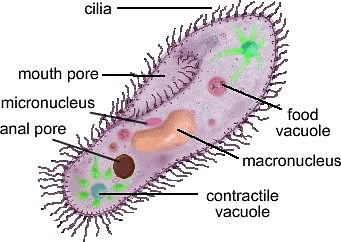 Protista
Protista
Q.2. The five-kingdom classification was proposed by
(a) R.H. Whittaker
(b) C. Linnaeus
(c) A. Roxberg
(d) Virchow
Ans. (a) R.H. Whittaker
Solution.
This phylogenetic classification was proposed by R.H. Whittaker (1969). He created a new kingdom ‘Fungi’.
The five-kingdom classification is as follows:
(i) Monera
(ii) Protista
(iii) Fungi
(iv) Plantae
(v) Animalia
Whittaker has used 5 criteria for the 5 kingdom classification and are as follows:
(i) Reproduction
(ii) Cell structure
(iii) Phylogenetic relationships
(iv) Mode of nutrition
(v) Thallus organisation
Q.3. Organisms living in salty areas are called:
(a) Methanogens
(b) Halophiles
(c) Heliophytes
(d) Thermoacidophiles
Ans. (b) Halophiles
Solution.
- Halophiles: Bacteria living in extremely salty areas.
- Thermoacidophiles: Bacteria living in hot springs/deep seawater.
Example: Thermococcus - Methanogens: Bacteria living in marshy areas and produce methane gas.
- Heliophytes: Sun-loving plants
Q.4. Naked cytoplasm, multi-nucleated and saprophytic are the characteristics of
(a) Monerans
(b) Protists
(c) Fungi
(d) Slime moulds
Ans. (d) Slime moulds
Solution.
Slime moulds are saprophytic protists, without cell walls. The spores of slime moulds possess true walls. The thalloid multinucleate body of a slime mould is called Plasmodium. Spores are dispersed by air currents.
Example:
(i) Acellular slime mould: Physarum
(ii) Cellular slime mould: Dictyostelium
Q.5. An association between roots of higher plants and fungi is called
(a) Lichen
(b) Fern
(c) Mycorrhiza
(d) BGA
Ans. (c) Mycorrhiza
Solution.
- The association of fungi with the roots of higher plants usually gymnosperms are known as Mycorrhiza.
- Lichens are symbiotic associations, i.e. mutually useful associations, between algae and fungi. This relationship is best known as helotism.
Q.6. A Dikaryon is formed when
(a) Meiosis is arrested
(b) The two haploid cells do not fuse immediately
(c) Cytoplasm does not fuse
(d) None of the above
Ans. (b) The two haploid cells do not fuse immediately
Solution.
In some fungi, the fusion of two haploid cells immediately results in diploid cells (2n). However, in other fungi (ascomycetes and basidiomycetes), an intervening dikaryotic stage (n + n, i.e. two nuclei per cell) occurs. Such a condition is called a dikaryon and the phase is called dikaryo phase of fungus. A dikaryotic cell has two dissimilar haploid nuclei.
Q.7. Contagium vivum fluidum was proposed by
(a) D. J. Ivanowsky
(b) M. W. Beijerinek
(c) Stanley
(d) Robert Hooke
Ans. (b) M. W. Beijerinek
Solution.
- D.J. Ivanowsky (1892) discovered the virus and has recognised certain microbes as a causal organism of the mosaic disease of tobacco.
- M.W. Beijerinck (1898) demonstrated that the extract of the infected plants of tobacco could cause infection in healthy plants and called the fluid as Contagium vivum fluidum (infectious living fluid).
- W. M. Stanley (1935) first time showed that viruses could be crystallized and crystals consist largely of proteins.
Q.8. Association between mycobiont and phycobiont are found in
(a) Mycorrhiza
(b) Root
(c) Lichens
(d) BGA
Ans. (c) Lichens
Solution.
Association between mycobiont and phycobiont are found in lichens.
Q.9. The Difference between Virus and Viroid is
(a) Absence of protein coat in viroid but present in the virus.
(b) Presence of low molecular weight RNA in the virus but absent in viroid.
(c) Both (a) and (b)
(d) None of the above.
Ans. (a) Absence of protein coat in viroid but present in the virus.
Solution.
Viroids are smaller than viruses and the cause of potato spindle tuber disease, and chrysanthemum stunt disease. It was found to be a free RNA and lacked the protein coat that is found in viruses, hence the name viroid.
Q.10. With respect to the fungal sexual cycle, choose the correct sequence of events.
(a) Karyogamy, Plasmogamy and meiosis
(b) Meiosis, Plasmogamy and Karyogamy
(c) Plasmogamy, Karyogamy and Meiosis
(d) Meiosis, Karyogamy and Plasmogamy
Ans. (c) Plasmogamy, Karyogamy and Meiosis
Solution.
The sexual cycle involves the following three steps:
(i) The fusion of protoplasms between two motile or non-motile gametes called plasmogamy. Plasmogamy is the fusion of two haploid cells without nuclear fusion.
(ii) The fusion of two nuclei is called Karyogamy.
(iii) Meiosis in zygote resulting in haploid spores.
Q.11. Viruses are non-cellular organisms but replicate themselves once they infect the host cell. To which of the following kingdoms do viruses belong?
(a) Monera
(b) Protista
(c) Fungi
(d) None of these
Ans. (d) None of these
Solution.
- Viruses did not find a place in classification since they are not truly ‘living’ if we understand living as those organisms that have a cell structure.
- Viruses are neither prokaryotes nor eukaryotes.
- They are inert outside their specific host cell and cannot multiply on their own because they lack cellular machinery to use their genetic material. Viruses can only multiply in a host or living cell.
Q.12. Members of Phycomycetes are found in
(i) Aquatic habitats
(ii) On decaying wood
(iii) Moist and damp places
(iv) As obligate parasites on plants
Choose from the following options:
(a) None of the above
(b) (i) and (iv)
(c) (ii) and (iii)
(d) All of the above
Ans. (d) All of the above
Solution.
Members of Phycomycetes are found in aquatic habitats, on decaying wood, moist and damp places and as obligate parasites on plants.
Very Short Answer Type Questions
Q.1. What is the principle underlying the use of cyanobacteria in agricultural fields for crop improvement?
Ans.
- Cyanobacteria (BGA) are autotrophic microbes.
- Cyanobacteria are widely distributed in aquatic and terrestrial environments.
- Nostoc, Ariabaena and Oscillatoria are BGA that can fix atmospheric nitrogen.
- These organisms can fix atmospheric nitrogen in specialised cells called heterocysts, e.g., Nostoc and Anabaena.
- In paddy fields, cyanobacteria serve as an important biofertiliser.
- BGA also add organic matter to the soil and increase its fertility.
Q.2. Suppose you accidentally find an old preserved permanent slide without a label. In your effort to identify it, you place the slide under the microscope and observe the following features:
(a) Unicellular
(b) Well-defined nucleus
(c) Biflagellate—one flagellum lying longitudinally and the other transversely.
What would you identify it as? Can you name the kingdom it belongs to?
Ans.
- Dinoflagellates are unicellular eukaryotes.
- Most of them have two flagella:
One lies longitudinally and the other transversely in a furrow between the wall plates. - Well-defined nucleus organisms are eukaryotes and unicellular organisms with eukaryotic cellular structures come under Protists.
- Dinoflagellates belong to the kingdom Protista.
Q.3. How is the five-kingdom classification advantageous over the two-kingdom classification?
Ans.
Two Kingdom system of classification with Plantae and Animalia kingdoms.
- Two kingdom classification did not distinguish between the prokaryotes and eukaryotes.
Example: It brought together the prokaryotic bacteria and blue-green algae with other groups (like plant, fungi and animals) which were eukaryotic. - Two kingdom classification did not distinguish between the unicellular and multicellular organisms.
Example: Chlamydomonas (unicellular) and Spirogyra (multicellular) were placed together under algae. - This system did not distinguish between autotrophic/photosynthetic (green algae and plants) and the heterotrophic/non-photosynthetic organisms (fungi).
Five Kingdom Classification:
(i) Fungi were placed in a separate kingdom—kingdom fungi.
(ii) It has put together, organisms which were placed in different kingdoms in earlier classifications.
(iii) Kingdom Protista brought together Chlamydomonas, Chlorella (earlier placed in algae within plants and both having cell walls) with Amoeba and Paramoecium (earlier placed in the animal kingdom and both lacking cell walls).
(iv) Animal and plant kingdoms become more homogenous than they are in the two kingdom classification. So, it is advantageous over the two kingdom classification.
Q.4. Polluted water bodies have usually a very high abundance of plants like Nostoc and Oscillatoria. Give reasons.
Ans.
- Polluted water bodies (ponds, ditches and rivers etc.) usually have nutrient contents (such as nitrate, phosphates).
- Domestic sewage primarily contains biodegradable organic matter. Presence of a large amount of nutrients in waters also causes excessive growth of planktons (free-floating algae) called an algal bloom, which imparts a distinct colour to water bodies.
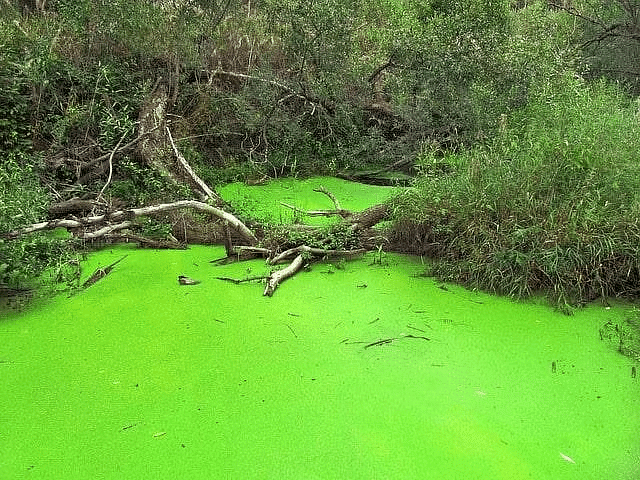 Algal Bloom
Algal Bloom - Algal bloom causes deterioration of water quality and fish mortality. Some bloom-forming algae, mainly Nostoc and Oscillitoria are extremely toxic to human beings and animals.
Q.5. Are chemosynthetic bacteria—autotrophic or heterotrophic?
Ans. Chemosynthetic bacteria oxidise various inorganic substances such as nitrates, nitrites and ammonia and use the released energy for their ATP production. So chemosynthetic bacteria are autotrophic in nature.
Q.6. The common name of pea is simpler than its botanical (scientific) name Pisum sativum. Why then is the simpler common name not used instead of the complex scientific/botanical name in biology?
Ans. As we know that pea (vernacular name or local name) is simpler than its botanical (scientific) name Pisum sativum. These local names would vary from place to place, even within a country.
One would probably recognize the confusion that would be created if we did not find ways and means to talk to each other and refer to organisms we are talking about.
Hence, there is a need to standardize the naming of living organisms such that a particular organism is known by the same name all over the world.
Q.7. A virus is considered as a living organism and an obligate parasite when inside a host cell. But the virus is not classified along with bacteria or fungi. What are the characters of the virus that are similar to non-living objects?
Ans. Viruses are living organisms inside a host cell. But the virus is not classified along with bacteria or fungi because they have an inert crystalline structure outside the living cell. They are inert outside their specific host cell and cannot multiply of their own because they lack cellular machinery to use its genetic material.
Q.8. In the five-kingdom system of Whittaker, how many kingdoms are eukaryotes?
Ans.
In Whittaker's five-kingdom system, four kingdoms (Protista, Fungi, Plantae and Animalia) belong to eukaryotes.
Short Answer Type Questions
Q.1. Diatoms are also called as ‘pearls of ocean’, why? What is diatomaceous earth?
Ans. The diatoms are unique organisms because of their distinctive cell walls. The walls are embedded with silica and thus the walls are indestructible. They show sculpturing and ornamentation that why Diatoms are also called as ‘Pearls of Ocean’.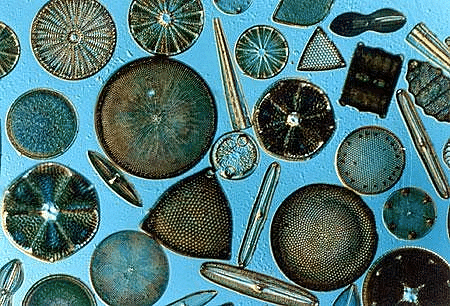 DiatomsDiatoms have left behind large amount of cell wall deposits in their habitat; this accumulation over billions of years is referred to as ‘diatomaceous earth’. Being gritty this soil is used in polishing, filtration of oils and syrups. Diatoms are the chief ‘producers’ in the oceans.
DiatomsDiatoms have left behind large amount of cell wall deposits in their habitat; this accumulation over billions of years is referred to as ‘diatomaceous earth’. Being gritty this soil is used in polishing, filtration of oils and syrups. Diatoms are the chief ‘producers’ in the oceans.
Q.2. There is a myth that immediately after heavy rains in forest, mushrooms appear in large number and make a very large ring or circle, which may be several metres in diameter. These are called ‘Fairy rings’. Can you explain this myth of fairy rings in biological terms?
Ans.
- After heavy rains in forest, moisture and nutrients pass down in the soil and activates the growth of mushroom mycelium.
- The basidiocarps of Agaricus (mushroom) arise from the mycelium present in the soil. They appear in a circle like a ring.
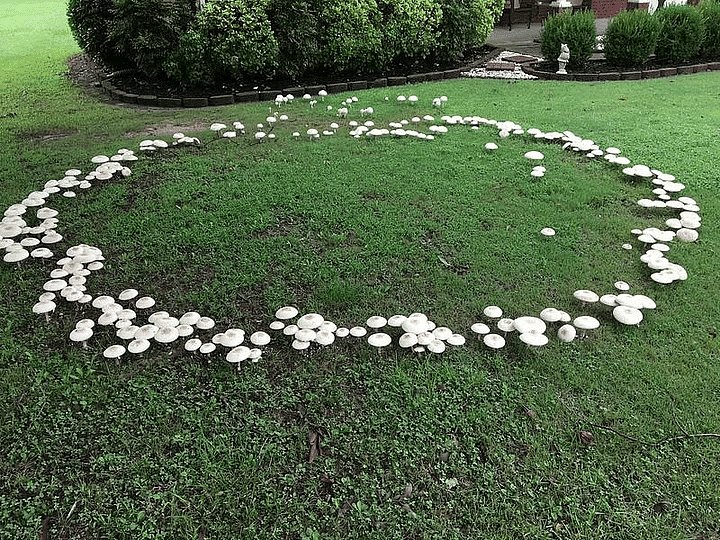 Fairy Rings
Fairy Rings - As these basidiocarps resemble buttons and grow in rings, they are known as fairy rings.
Q.3. Neurospora—an ascomycetes fungus has been used as a biological tool to understand the mechanism of plant genetics much in the same way as Drosophila has been used to study animal genetics. What makes Neurospora so important as a genetic tool?
Ans.
- Neurospora is used as a genetic tool because it is easy to grow and has a haploid life cycle that makes genetic analysis simple since recessive traits will show up in the offspring.
- Beadle and Tatum exposed Neurospora crassa to X-rays, causing mutations. This led them to propose the “one gene, one enzyme” hypothesis that specific genes code for specific proteins.
Q.4. Cyanobacteria and heterotrophic bacteria have been clubbed together in Eubacteria of kingdom Monera as per the “Five Kingdom Classification” even though the two are vastly different from each other. Is this grouping of the two types of taxa in the same kingdom justified? If so, why?
Ans.
- Cyanobacteria and heterotrophic bacteria have been clubbed together in Eubacteria of Kingdom Monera as per the “Five Kingdom Classification” because they do not have the nuclear envelope and membrane-bound organelles. Their genetic material is naked.
- They have 70S type of ribosomes. So, cyanobacteria and heterotrophic bacteria are prokaryotes and belong, to Kingdom Monera.
Q.5. At a stage of their cycle, ascomycetes fungi produce the fruiting bodies like apothecium, perithecium or cleistothecium. How are these three types of fruiting bodies different from each other?
Ans.
- An apothecium is a wide, open, saucer-shaped or cup-shaped fruit body. It is sessile and fleshy.
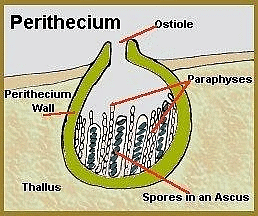
- A cleistothecium is a globose, completely closed fruit body with no special opening to the outside.
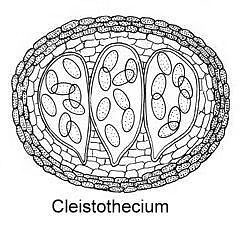
- Perithecium are flask-shaped structures opening by a pore or ostiole (short papilla opening by a circular pore).Perithecium
Q.6. What would observable features in Trypanosoma make you classify it under Kingdom Protista?
Ans.
Trypanosoma is classified under the Kingdom Protista because it is unicellular eukaryotes. It has a well-defined nucleus with the nuclear envelope, membrane-bound organelles, 80S ribosomes and flagella with 9 + 2 organisation.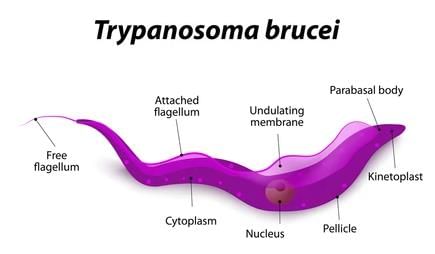
Q.7. Fungi are cosmopolitan. Write the role of fungi in your daily life.
Ans.
- Dough which is used for making bread, is fermented by fungi Saccharomyces cerevisiae (Baker’s yeast).
- Roquefort cheese are ripened by growing a specific fungi on them, which gives them a particular flavor.
- Microbes mainly yeasts used for the production of beverages like wine, beer, whisky, brandy or rum. For this purpose the yeast (Saccharomyces cerevisiae) used for fermenting malted cereals and juices to produce ethanol and commonly called Brewer’s yeast.
Antibiotics Produced by Fungi:
- Cyclosporin A is produced by Trichoderma polysporum (Fungus). Cyclosporin A is used as an immunosuppressive agent in organ transplant patients.
- Statins produced by Monascus purpureus (Yeast). Statins used as blood- cholesterol-lowering agent.
- Mushrooms, morels (Morchella) and truffles are edible fungi.
- Fungi causes several diseases in plants and animals including human beings.
Long Answer Type Questions
Q.1. Algae are known to reproduce asexually by variety of spores under different environmental conditions. Name these spores and the conditions under which they are produced.
Ans. Asexual reproduction is by the production of different types of spores, the most common being the zoospores. They are flagellated (motile) and on germination gives rise to new plants.
Types of asexual reproduction:
(i) Zoospores: Motile and formed in favourable condition.
(ii) Aplanospores: Thin-walled, non-motile and formed in unfavourable condition.
(iii) Hypnospore: Thick-walled, non-motile and formed in unfavorable condition.
(iv) Akinete: Under unfavorable condition, entire cell becomes thick.
(v) Palmella stage: In condition of drought, protoplast is surrounded by gelatinous covering.
Q.2. Apart from chlorophyll, algae have several other pigments in their chloroplast. What pigments are found in blue-green, red and brown algae that are responsible for their characteristic colors?
Ans. Apart from chlorophyll, algae have several other pigments in their chloroplast like carotenoids, xanthophylls (fucoxanthin) and r-phycoerythrin.
(a) In blue-green algae, phycocyanin and r-phycoerythrin pigments are present beside chlorophyll a.
(b) Brown algae possess chlorophyll a, c, carotenoids and xanthophylls. They vary in colour from olive green to various shades of brown depending upon the amount of the xanthophyll pigment, fucoxanthin present in them.
(c) Red algae possess chlorophyll a, d and phycoerythrin in their body. Rhodophyceae members are commonly called red algae because of the predominance of the red pigment, r-phycoerythrin in their body.
Q.3. Make a list of algae and fungi that have commercial value as source of food, chemicals, medicines and fodder.
Ans.
(a) Economic Importance of Algae
- Many species of Porphyra, Laminaria and Sargassum, are among the 70 species of marine, algae used as food. Chlorella and Spirulina are unicellular algae, rich in proteins and are used as food supplements even by space travellers.
- Certain marine brown and red algae produce large amounts of hydrocolloids (water holding substances) or phycocolloids.
Example: Algin (brown algae) and Carrageen (red algae) are used commercially. Agar, one of the commercial products obtained from Gelidium and Gracilaria are used to grow microbes and in preparations of ice-creams and jellies. - Bromine is obtained from red algae Polysiphonia. Macrocystis is the source of Potash. Laminaria and Fucus are the sources of Iodine.
(b) Economic Importance of Fungi
- Mushrooms, morels (Morchella) and truffles are edible fungi.
- Microbes mainly yeasts used to produce beverages like wine, beer, whiskey, brandy or rum. For this purpose the yeast (Saccharomyces cerevisiae) is used to ferment malted cereals and juices to produce ethanol and commonly called Brewer’s yeast.
(i) Cyclosporin A is produced by Trichoderma polysporum (Fungus). Cyclosporin A is used as an immunosuppressive agent in organ transplant patients.
(ii) Statins produced by Monascus purpureus (Yeast). Statins used as the blood-cholesterol lowering agent.
Antibiotics Produced by Fungi:
Q.4. ‘Peat’ is an important source of domestic fuel in several countries. How is ‘peat’ formed in nature?
Ans.
- Species of Sphagnum, a moss, provide peat that have long been used as fuel and because of their capacity to hold water as packing material for trans-shipment of living material.
- Peat forms when plant material decaying fully by acidic and anaerobic conditions.
- Peat is soft and easily compressed. Under pressure, water in the peat is forced out. Upon drying, peat can be used as fuel.
Q.5. Biological classification is a dynamic and ever-evolving phenomenon which keeps changing with our understanding of life forms. Justify the statement taking any two examples.
Ans.
- Kingdom Protista brought together Chlamydomonas, Chlorella (earlier placed in algae within plants and both having cell walls) with Amoeba and Paramoecium (earlier placed in the animal kingdom and both lacking cell walls).
- Five kingdom classification has put together organisms (like Chlamydomonas and Amoeba) which were placed in different kingdoms in earlier classifications.
- This change happened because the criteria for classification changed. This kind of changes will take place in future too depending on the improvement in our understanding of characteristics and evolutionary relationships.
- So, biological classification is a dynamic and ever-evolving phenomenon which keeps changing with our understanding of life forms.
|
169 videos|524 docs|136 tests
|
FAQs on NCERT Exemplar: Biological Classification - Biology Class 11 - NEET
| 1. What are the five kingdoms of biological classification? |  |
| 2. What is the basis of classification in the biological system? |  |
| 3. How are organisms classified into different kingdoms? |  |
| 4. What is the importance of biological classification? |  |
| 5. How does biological classification help in identifying and naming organisms? |  |





















